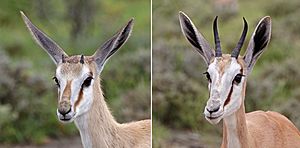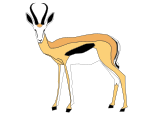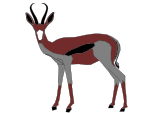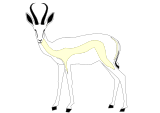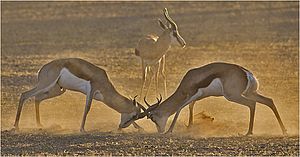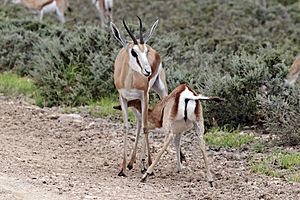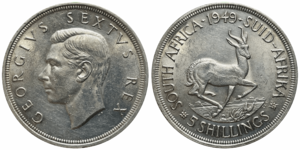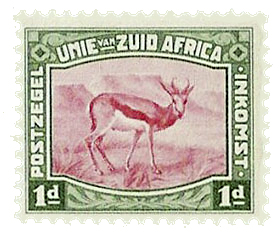Springbok facts for kids
Quick facts for kids Springbok |
|
|---|---|
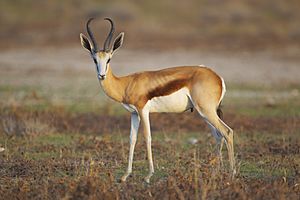 |
|
| Male at Etosha National Park | |
| Conservation status | |
| Scientific classification | |
| Genus: |
Antidorcas
|
| Species: |
marsupialis
|
| Subspecies | |
|
|
| Synonyms | |
|
List
Antidorcas euchore (Sundevall, 1847)
Antilope dorsata (Daudin, 1802) A. marsupialis (Zimmermann, 1780) A. saccata (Boddaert, 1785) A. saliens (Daudin, 1802) A. saltatrix (Link, 1795) Capra pygargus (Thunberg, 1795) Cemas marsupialis (Oken, 1816) Cerophorus euchore (de Blainville, 1816) Gazella sautante (Burton, 1782) |
|
The springbok (Antidorcas marsupialis) is a type of antelope. It lives mostly in southern and southwestern Africa. This animal is the only member of its genus, Antidorcas. A German scientist named Eberhard August Wilhelm von Zimmermann first described it in 1780. There are three different types, or subspecies, of springbok.
Springboks are slender and have long legs. They stand about 71 to 86 cm (28 to 34 in) tall at the shoulder. They weigh between 27 and 42 kg (60 and 93 lb). Both male and female springboks have black horns. These horns are about 35-to-50 cm (14-to-20 in) long and curve backward. Springboks have a white face with a dark stripe from their eyes to their mouth. Their body is light brown with a reddish-brown stripe along their sides. They also have a white flap of skin on their rump.
Springboks are most active in the morning and evening. They live in herds where males and females mix. Long ago, huge groups of springboks would migrate across the Kalahari and Karoo. This was called trekbokking. A special thing springboks do is called pronking. This is when they jump high into the air, up to 2 m (6.6 ft) off the ground. They do this with stiff legs and a bowed back, lifting their white rump flap.
Springboks mainly eat shrubs and succulent plants. They can live for years without drinking water. They get all the water they need from the plants they eat. Springboks can have babies all year round. But most babies are born in the rainy season when there is plenty of food. A single baby is born after about five to six months. The baby drinks milk for almost six months. It then leaves its mother a few months later.
Springboks live in dry areas of southern and southwestern Africa. The IUCN says the springbok is a "least concern" species. This means they are not in danger of disappearing. In fact, their numbers are growing. People often hunt springboks for their meat and skin. The springbok is also the national animal of South Africa.
Contents
What's in a Name?
The name "springbok" was first used in 1775. It comes from the Afrikaans words spring (meaning "jump") and bok (meaning "antelope" or "goat").
The scientific name is Antidorcas marsupialis. Anti is a Greek word meaning "opposite." Dorcas means "gazelle." So, Antidorcas means "not a gazelle." The word marsupialis comes from the Latin word marsupium, which means "pocket." This refers to a special pocket-like skin flap on the springbok's back. This flap helps tell springboks apart from true gazelles.
Springbok Family Tree
The springbok belongs to the family Bovidae. This family includes animals like cows, goats, and other antelopes. The German scientist Eberhard August Wilhelm von Zimmermann first described the springbok in 1780. Later, in 1845, a Swedish scientist named Carl Jakob Sundevall placed the springbok in its own genus, Antidorcas. It is the only living animal in this group.
Springbok Subspecies
There are three types of springbok:
- A. m. angolensis (Blaine, 1922) – Found in southwestern Angola.
- A. m. hofmeyri (Thomas, 1926) – Lives north of the Orange River. This includes parts of Botswana and Namibia.
- A. m. marsupialis (Zimmermann, 1780) – Found south of the Orange River. This includes areas in the Cape of Good Hope and the Free State in South Africa.
How Springboks Evolved
Scientists have found springbok fossils from the Pliocene era. This means springboks likely evolved about three million years ago. They probably came from an ancestor that looked like a gazelle. Three fossil species of Antidorcas have been found. They used to live all over Africa. Two of these species, A. bondi and A. australis, died out about 7,000 years ago. The third species, A. recki, likely led to the springbok we see today. This happened during the Pleistocene period, about 100,000 years ago.
What Springboks Look Like
The springbok is a slender antelope. It has long legs and a long neck. Both males and females are about 71–86 cm (28–34 in) tall at the shoulder. Their body length is usually between 120 and 150 cm (47 and 59 in). They weigh between 27 and 42 kg (60 and 93 lb). Their tail is 14 to 28 cm (5.5 to 11.0 in) long and has a short black tuft at the end. The different subspecies can vary in size and weight.
Springboks have dark stripes on their white face. These stripes go from their eyes to their mouth. There is also a dark patch on their forehead. Young springboks have lighter brown stripes and patches. Their ears are narrow and pointed, measuring 15–19 cm (5.9–7.5 in).
Their coat is usually light brown. A dark reddish-brown band runs along their side. This band separates their dark back from their white belly. The tail, buttocks, and inside of their legs are all white.
There are also rare black and white springbok forms. These are bred on some farms in South Africa. Black springboks are born very dark. As they grow, they become chocolate-brown. They also get a white mark on their face. White springboks are mostly white. They have a light tan stripe on their sides.
The skin along the middle of their back is folded inward. It is covered with 15 to 20 cm (5.9 to 7.9 in) long white hair. This hair is usually hidden by the brown hairs around it. But when the springbok lifts its back, this fold opens up. This is a key feature that makes springboks different from gazelles.
Springboks also have different teeth than gazelles. They have two premolars on each side of their jaw. Gazelles have three. This means springboks have 28 teeth in total, while gazelles have 32. Springboks also have a longer, wider, and stiffer nose bridge. Their cheeks are more muscular. Their horns are also shaped differently.
Both male and female springboks have black horns. They are about 35–50 cm (14–20 in) long. The horns are straight at the base and then curve backward. In one subspecies, A. m. marsupialis, females have thinner and shorter horns than males. For the other two subspecies, the horns of males and females are quite similar.
Springbok Life and Behavior
Springboks are mostly active around sunrise and sunset. If it's hot, they might feed at night. If it's cold, they might feed in the middle of the day. They rest in the shade of trees or bushes. When it's cooler, they often lie down in open areas.
Springboks live in social groups. They form mixed-sex herds, also called harems. These herds usually have about three females for every male. Some male springboks live alone or in groups with other males. During mating season, males form herds and look for mates. Females live with their young in separate herds. These herds rarely include dominant males.
Male springboks set up their own areas, called territories, during mating season. These areas can be from 10 to 70 hectares (25 to 173 acres) in size. They mark their territory by urinating and leaving piles of dung. Males in nearby territories often fight over females. They twist and push each other with their horns. Females can move through the territories of different males.
Outside of mating season, mixed-sex herds can have anywhere from 3 to 180 springboks. All-male herds usually have no more than 50. Herds with mothers and their young are much smaller, usually less than 10 animals.
Long ago, millions of springboks would migrate in huge herds. These herds could be hundreds of kilometers long. They would take days to pass through a town. These mass migrations, called trekbokking, happened during long dry periods. Springboks could find their way back to their home areas after these long journeys. Today, trekbokking still happens sometimes in Botswana, but on a much smaller scale.
Springboks often do repeated high leaps into the air. This is called pronking or stotting. The word pronk comes from Afrikaans and means "to show off." When pronking, the springbok jumps with stiff legs. Its back is bowed, and its white flap is lifted. When a male springbok wants to show off or warn off a predator, it starts with a stiff trot. Then it leaps into the air with an arched back. It lifts the flap along its back. This makes the long white hairs under its tail stand up like a fan. This also releases a strong smell of sweat.
Scientists don't know exactly why springboks pronk. But they do it when they are nervous or excited. One idea is that it warns other springboks about danger. It might also confuse a predator. Or it could be a way to get a better view of a hidden predator. It might also be a way for springboks to display their strength.

Springboks are very fast antelopes. They can run up to 88 km/h (55 mph). Predators usually leave them alone unless they are breeding. Major predators include Cheetahs, lions, leopards, spotted hyenas, wild dogs, caracals, crocodiles, and pythons. Smaller predators like Southern African wildcats, black-backed jackals, and large eagles hunt young springboks. Springboks are usually quiet. But they might make low grunting sounds to greet each other. They make high-pitched snorts when they are alarmed.
Springbok Diet

Springboks mostly eat by browsing. This means they eat leaves, twigs, and shrubs. Sometimes they will graze on grasses. They prefer shrubs and young succulent plants. These plants are soft before they become woody. Springboks can get all the water they need from their food. This means they can survive without drinking water, even in dry seasons. In some cases, they never drink water in their whole lives. They do this by choosing to eat flowers, seeds, and leaves of shrubs early in the morning. At this time, the plants are most juicy. In places like Etosha National Park, springboks will drink water if it's available.
Springbok Reproduction and Life Cycle
Springboks can mate all year round. But females are more likely to have babies during the rainy season. This is when there is more food. Females can start having babies as early as six or seven months old. Males are not ready to mate until they are two years old.
Pregnancy lasts for five to six months. Usually, one calf is born, but sometimes twins can occur. Most births happen in the spring (October to November). This is before the rainy season starts. A newborn calf weighs about 3.8 to 5 kg (8.4 to 11.0 lb). The mother hides her calf in a safe place while she is away. The mother and calf join the herd again about three to four weeks after the birth. The young springboks drink milk for five or six months. When the mother has another baby, her older offspring (now 6 to 12 months old) leaves her. They join herds of adult springboks. A female springbok can have two babies a year. She might even have three if one calf dies. Springboks can live for up to 10 years in the wild.
Where Springboks Live
Springboks live in the dry parts of southern and southwestern Africa. Their home range goes from northwestern South Africa. It stretches through the Kalahari desert into Namibia and Botswana. The Transvaal is the eastern edge of their range. From there, it goes west to the Atlantic coast. It also goes north to southern Angola and Botswana. In Botswana, they are mostly found in the Kalahari desert. They are common across Namibia. They also live in the large grasslands of the Free State and the shrublands of Karoo in South Africa. In Angola, they are found only in the Namib Desert.
Historically, springboks lived across the dry grasslands, bushlands, and shrublands of southwestern and southern Africa. They used to migrate sometimes in the southern parts of their range. These large migrations are rare now. But you can still see groups of springboks gathering in areas with short plants, like the Kalahari desert.
Predators
Protecting Springboks
The springbok is listed as "least concern" by the IUCN Red List. This means there are no major threats to their long-term survival. The springbok is one of the few antelope species whose population is actually growing.
Springboks live in several protected areas. These include:
- Makgadikgadi and Nxai National Park (Botswana)
- Kgalagadi Transfrontier Park (between Botswana and South Africa)
- Etosha National Park and Namib-Naukluft Park (Namibia)
- Mokala and Karoo National Parks (South Africa)
- Many other provincial reserves in South Africa.
In 1999, an expert estimated there were over 670,000 springboks in South Africa. Other estimates for all of southern Africa suggested a total population of nearly 2 to 2.5 million animals. Springboks are also managed on many private farms. Small groups have been moved to private lands and provincial areas in KwaZulu-Natal.
Springboks and People
People hunt springboks in Namibia, Botswana, and South Africa. They are popular for hunting because there are many of them. They are also easy to raise on farms. Exporting springbok skins is a big business. These skins are used for taxidermy models. Springbok meat is also very popular. You can find it in South African supermarkets. In 2011, springbok meat made up about two-thirds of the game meat from Namibian farms. A lot of this meat is exported to other countries.
The springbok has been a national symbol of South Africa for a long time. It was used as a nickname or mascot for many South African sports teams. The most famous is the national rugby union team. The winged springbok was also the logo for South African Airways from 1934 to 1997. The springbok is the national animal of South Africa. Even after Apartheid ended, Nelson Mandela helped keep the springbok name for the rugby team. This helped bring rugby fans together. The springbok is also shown on the back of the South African Krugerrand coin.
The cap badge of The Royal Canadian Dragoons has had a springbok on it since 1913. This is because the unit was involved in the Second Boer War.
See also
 In Spanish: Gacela saltarina de El Cabo para niños
In Spanish: Gacela saltarina de El Cabo para niños



